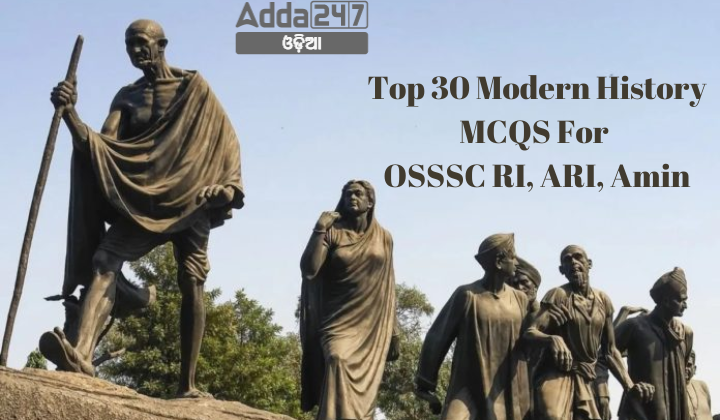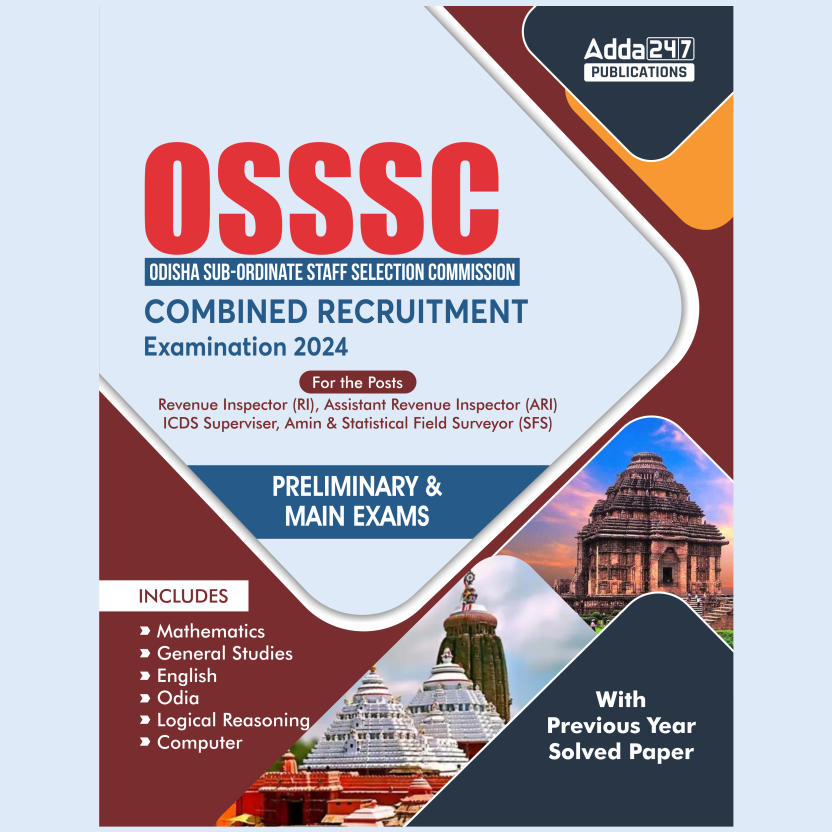Preparing for competitive exams such as OSSSC RI (Revenue Inspector), ARI (Assistant Revenue Inspector), Amin, SFS, or ICDS Supervisor often requires a strong grasp of historical events. Modern history, especially, forms a significant part of the syllabus, covering crucial periods and events that shaped the world as we know it today. To aid in your preparation, here are 30 multiple-choice questions (MCQs) focusing on modern history:
Top 30 Modern History MCQs for OSSSC RI,ARI, Amin, SFS, ICDS Supervisor
- The Charter Act of 1813 was primarily enacted to:
(a) Extend the rule of the East India Company in India
(b) End the British trade monopoly in India completely
(c) Grant independence to Indian territories
(d) Establish complete British sovereignty over India
Ans: (a) Extend the rule of the East India Company in India - Which of the following was not a monopoly retained by the East India Company after the enactment of the Charter Act of 1813?
(a) Trade with China
(b) Tea trade
(c) Trade with Europe
(d) Opium trade
Ans: (c) Trade with Europe - The Charter Act of 1813 allowed British missionaries to:
(a) Trade in Indian territories
(b) Engage in religious proselytization in India
(c) Govern Indian provinces
(d) Establish schools exclusively for Europeans
Ans: (b) Engage in religious proselytization in India - Which of the following statements is true regarding the Charter Act of 1813?
(a) It imposed a total ban on Indian literature and scientific studies
(b) It provided financial grants for the promotion of Indian literature and science
(c) It restricted education in India to only Europeans
(d) It reduced the powers of the local Indian courts over Europeans
Ans: (b) It provided financial grants for the promotion of Indian literature and science - What was the fixed dividend percentage for the East India Company as per the Charter Act of 1813?
(a) 8.5%
(b) 9.5%
(c) 10.5%
(d) 11.5%
Ans: (c) 10.5% - Under the Charter Act of 1813, the East India Company’s rule was extended by:
(a) 10 years
(b) 15 years
(c) 20 years
(d) 25 years
Ans: (c) 20 years - The Charter Act of 1813 gave more powers to which courts over European British subjects?
(a) Indian local courts
(b) British High Court
(c) French courts in India
(d) Supreme Court in Calcutta
Ans: (a) Indian local courts - The Charter Act of 1813 was repealed by which subsequent act?
(a) Government of India Act, 1858
(b) Indian Independence Act, 1947
(c) Government of India Act, 1915
(d) Regulating Act, 1773
Ans: (c) Government of India Act, 1915 - Which of the following was one of the main reasons behind the enactment of the Charter Act of 1813?
(a) The decline of the Mughal Empire
(b) The Continental System in Europe by Napoleon Bonaparte
(c) The First Anglo-Maratha War
(d) The demand for Indian independence
Ans: (b) The Continental System in Europe by Napoleon Bonaparte - The Charter Act of 1813 made provisions for the appointment of which religious figure in India?
(a) Archbishop
(b) Bishop
(c) Cardinal
(d) Imam
Ans: (b) Bishop - Who established the Calcutta Madrassa in 1781 for the teaching of Muslim law?
(a) Warren Hastings
(b) Jonathan Duncan
(c) Lord Dalhousie
(d) Sir Charles Wood
Ans. (a) Warren Hastings - Which of the following was the first step towards making education a government objective in India?
(a) Wood’s Despatch
(b) Charter Act of 1813
(c) Macaulay’s Minutes
(d) Hunter Commission
Ans. (b) Charter Act of 1813 - Who is associated with the establishment of a Sanskrit College in Varanasi in 1791?
(a) William Carey
(b) Warren Hastings
(c) Jonathan Duncan
(d) Charles Wood
Ans. (c) Jonathan Duncan - What was the main reason for the British to promote education in India?
(a) To educate Indians for clerical jobs
(b) To spread Western culture and values
(c) To introduce scientific education
(d) To promote religious harmony
Ans. (a) To educate Indians for clerical jobs - Who among the following was an ardent supporter of English education and proposed the ‘infiltration theory’?
(a) James Prinsep
(b) Thomas Babington Macaulay
(c) Warren Hastings
(d) Henry Thomas Colebrooke
Ans. (b) Thomas Babington Macaulay - The Elphinstone College in Bombay and the Calcutta Medical College were established in which year?
(a) 1791
(b) 1835
(c) 1854
(d) 1882
Ans. (b) 1835 - Which document is known as the ‘Magna Carta of English education in India’?
(a) Charter Act of 1813
(b) Macaulay’s Minutes
(c) Wood’s Despatch
(d) Hunter Commission Report
Ans. (c) Wood’s Despatch - The Wood’s Despatch of 1854 emphasized the education of which of the following groups?
(a) Indian women
(b) British settlers
(c) Indian farmers
(d) Indian merchants
Ans. (a) Indian women - Which universities were established as a result of Wood’s Despatch by 1857?
(a) Universities of Madras, Calcutta, and Bombay
(b) University of Punjab and University of Allahabad
(c) Delhi University and Banaras Hindu University
(d) Aligarh Muslim University and Osmania University
Ans. (a) Universities of Madras, Calcutta, and Bombay - In 1921, what was the approximate illiteracy rate in British India?
(a) 92%
(b) 80%
(c) 70%
(d) 50%
Ans. (a) 92% - Which of the following was a key feature of the Charter Act of 1833?
(a) The company’s commercial activities were expanded.
(b) The company’s commercial activities were closed down.
(c) The company was allowed to trade freely with China.
(d) The company was granted new trading rights in India.
Ans: (b) The company’s commercial activities were closed down. - Who was the first Governor-General of India as per the Charter Act of 1833?
(a) Lord Wellesley
(b) Lord Dalhousie
(c) Lord William Bentinck
(d) Lord Cornwallis
Ans: (c) Lord William Bentinck - Which act legalised the British colonisation of India?
(a) Regulating Act of 1773
(b) Pitt’s India Act of 1784
(c) Charter Act of 1813
(d) Charter Act of 1833
Ans: (d) Charter Act of 1833 - The Charter Act of 1833 provided for which of the following regarding the Governor-General’s powers?
(a) Legislative powers were limited to Bengal.
(b) Legislative powers were extended over entire British India.
(c) Governor-General had no legislative powers.
(d) Legislative powers were extended over only Madras and Bombay.
Ans: (b) Legislative powers were extended over entire British India. - Which of the following statements is true about the Indian Law Commission established by the Charter Act of 1833?
(a) It sought to codify all British law.
(b) It sought to codify all Indian law.
(c) It sought to codify all European law.
(d) It sought to codify only religious law.
Ans: (b) It sought to codify all Indian law. - According to the Charter Act of 1833, who could be employed in government service?
(a) Only British citizens
(b) Only members of the East India Company
(c) Indians, based on merit
(d) Indians, based on their caste
Ans: (c) Indians, based on merit - What was one of the significant outcomes of the Charter Act of 1833 regarding the Presidency of Bengal?
(a) Bengal was divided into Agra and Fort William presidencies.
(b) Bengal was unified with Madras.
(c) Bengal remained undivided as the division was never implemented.
(d) Bengal was made a separate entity from British India.
Ans: (c) Bengal remained undivided as the division was never implemented. - How did the Charter Act of 1833 address the issue of slavery in India?
(a) It ignored the issue of slavery.
(b) It encouraged slavery.
(c) It provided for the mitigation of slavery.
(d) It abolished slavery immediately in India.
Ans: (c) It provided for the mitigation of slavery. - How did the Charter Act of 1833 impact the governance structure in India?
(a) It decentralized the administration.
(b) It unified the country’s administration under one control.
(c) It split the administration between British and Indian leaders.
(d) It granted full autonomy to Indian princely states.
Ans: (b) It unified the country’s administration under one control. - What change did the Charter Act of 1833 bring about concerning the religious establishment in India?
(a) It restricted the number of Bishops to one in India.
(b) It prohibited the establishment of Christian institutions.
(c) It allowed for the establishment of three Bishops in India.
(d) It mandated the closure of Christian institutions in India.
Ans: (c) It allowed for the establishment of three Bishops in India.










